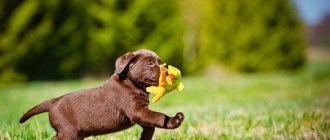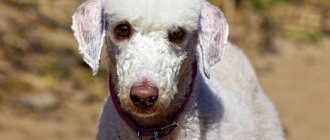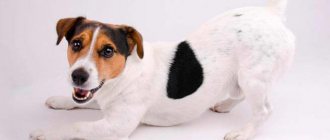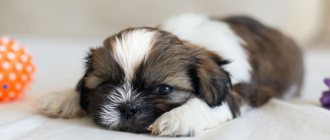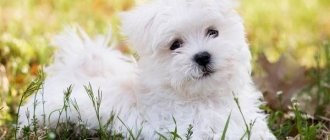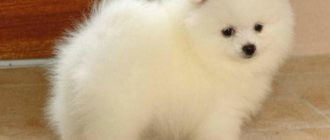The Labrador Retriever is one of the most popular dog breeds. She gained universal love and respect thanks to her kind disposition, philanthropy and boundless devotion.
In this article we will tell you everything about the Labrador: standards and characteristics of the breed, caring for a puppy and an adult dog, education and training.
Brief history of origin
Today there is no reliable information about the history of the origin of the Labrador Retriever breed. There is a version that a “little Newfoundland” dog was found on the island of Newfoundland. These animals were very hardworking and resilient. They helped fishermen and hunters.
In the 19th century, these dogs were brought to England, where they were crossed with the Curly-Coated Retriever. The result of this experiment was a Labrador. In the twentieth century they appeared in America.
The first breed standard was established in England in 1988, in the USA in 1994.
Gender character traits
The breed's sexual dimorphism is weak: females are more elegant and graceful than males, but nothing more. The main differences are hidden in the nuances of temperament. The girl's Labrador character is domestic, affectionate and loving. The toothy young ladies are obedient and calm, they become strongly attached to the owner and his household. Problems with Labrador girls arise twice a year, during empty periods. At this time, a nervous and tense dog should be kept on a leash and given more attention and love.
The character of a boy Labrador is impulsive, playful, curious and restless. If a dog is poorly trained, he will endlessly run away, get lost, and end up in bad situations. At home, the aristocrat labre magically transforms: imposing mannerism, tact, comfort, charm and complaisance.
Regardless of gender choice, the Labrador breed so many advantages that the shortcomings are simply invisible.
Interesting facts about Labradors
- Labrador dogs have a high pain threshold, so without hesitation they rush into the epicenter of misfortune to save people. Thanks to this feature of the breed and their good sense of smell, Labrador retrievers often become assistants to the police and the Ministry of Emergency Situations.
- Labradors are waterfowl dogs: they have water-repellent fur, webbed paws and a tail that acts as a rudder.
- Labradors are used for canistherapy in cancer centers, hospitals for the mentally ill and to treat children with psychological problems.
Labrador: breed standard
These animals are characterized by a strong, proportional physique. The weight of adult individuals varies from 25 to 36 kilograms with a height at the withers of 55-57 centimeters. The well-sculpted massive skull has drooping, not too large ears. The flat, strong back ends in a thick tail at the base, but gradually tapering.
The body of the animal is covered with short, thick, hard-to-touch fur. There should be no waves or frays on it. Beneath it lies a dense, waterproof undercoat. In dark-colored dogs, one light spot is allowed. As a rule, it is located in the area of a fairly wide chest. The animal's eyes should be brown or hazel in color.
Breed description, standards and appearance
The FCI gives the following description of the Labrador Retriever: a large dog with a strong, muscular build. The dog is active and hardy, so he is often taken hunting.
The International Canine Association has established the following standards for the Labrador Retriever breed:
Labrador is a medium or even large breed. The size of a Labrador Retriever depends on its gender:
The characteristics of the breed allow for 3 canine growth standards:
- international - allows a deviation from the standard of 1 cm;
- British – deviation of more than 1 cm;
- American – deviation of 3–5 cm.
Weight, as a rule, is not strictly regulated.
Varieties of Labradors
Labradors have no pedigree species. But there is an unspoken division between American and European. The first ones are slightly larger and yellower (in light-colored individuals).
The European type is characterized by medium height and light coat.
Color and coat type
There are three types of Labradors by color:
- black;
- brown (chocolate);
- fawn.
Black coloring for Labrador Retrievers is considered classic; a white spot on the chest is allowed. The first dogs of this breed were pure black (both coat and undercoat), other colors were recognized relatively recently.
Fawn Labradors are found in the following shades:
- golden;
- light red;
- cream;
- peach;
- light grey.
This is interesting! There are no pure white Labradors.
The rarest type of Labrador color is chocolate. With this color, the presence of a white spot on the chest is also acceptable.
The Labrador Retriever's coat is short, thick, water-repellent, and lies close to the skin.
Due to the fact that not everyone knows exactly what a Labrador looks like, fawn Labrador retrievers are confused with golden retrievers. They are really similar in appearance and muzzle, but differ in the type of coat. Labrador Retriever is smooth-haired.
A curly and shaggy coat is a defect in the breed.
The Golden Retriever has a soft, long, curly, and wavy coat.
Breed varieties. Difference between Labrador and Retriever
The varieties of the Labrador breed include mixed breeds.
The most popular and quite young is a cross between a Labrador and a poodle - a Labradoodle or Cobberdog.
In addition to the Cobberdog, there is a Labrador mix:
- with a German Shepherd . They absorbed the best qualities of the two breeds.
- with husky . These dogs have inherited the mesmerizing eyes of the husky.
- with Shar Pei . They have a cute appearance due to the large number of folds.
Very often there is confusion between the two breeds: retriever and labrador; what is the difference?
This happens because of the full names of the breeds - Labrador Retriever and Golden Retriever . In fact, these are completely different species.
The main difference is the origin. Some originated from dogs of Indian tribes, and another breed was started by the Scotsman Lord Tweedmouth.
The nature of a Labrador and a retriever also differs. The former are emotional and open, while the retriever exhibits the habits of an aristocrat - restraint, touchiness.
Labrador retrievers come in three colors: black, cream, and brown. And the color of the retriever varies only from light to dark gold .
Important! Wool is the main distinguishing feature of the Labrador. It is short, thick and dense. While the retriever's coat is long, shiny, light and wavy.
Character and behavior of the Labrador
Labrador retrievers are among the kindest, family dogs. They are good-natured, open, cheerful, full of love and tenderness. This breed is distinguished by its boundless devotion to its owners. They are ready to do everything to please their beloved household members, and everyone around them.
Labrador dogs are famous for their well-developed hunting skills. Their keen sense of smell, physical qualities, energy and endurance help to track and pursue prey.
They are not suitable for the role of security guards, since they treat all strangers warmly and friendly.
Labradors are absolutely not characterized by aggressiveness. They are good with other animals.
Breed and children
Labrador Retrievers and children always make good friends. This is due to the fact that the characters of pets and babies are very similar. Both the Labrador and the child are cheerful, inquisitive, open-minded, and love to play and frolic for a long time.
Labradors are very affectionate, neat animals, so they will not harm a child. In addition, these dogs have a positive effect on children. You don’t have to worry that your child will spend all his time watching the TV or computer screen, because he will be interested in training or just walking with the retriever.
If there are very young children in the house, it is worth first making sure that the puppy does not accidentally touch the baby while flirting.
Main character traits
Labrador retrievers exhibit the following behavior:
- Cheerfulness and love for others - dogs of this breed love the whole world around them. The Labrador's good attitude extends to the people and animals in the house. The dog sincerely loves everyone and believes that everyone loves him. The reason for this is the character and childish perception of the world; a Labrador feels like a puppy until it is 3 years old.
- Love of movement - this dog cannot live without physical activity, it moves, jumps, and plays all the time. A passionate fan of water treatments, he loves to swim in ponds. Labrador Retrievers need quality, long-term walking.
- Loyalty – the breed is infinitely loyal to its owner and family. He treats children with adoration and never tires of entertaining them.
- Kindness and tolerance is one of the few breeds without natural aggressiveness . The Labrador Retriever never bites or growls (such cases are extremely rare and are explained by the cruelty of the owners or the extreme nature of the situation). Allows children to stroke and touch themselves. Calmly and courageously endures being pulled by the tail, ears, paws and fur. He rides very young children on himself.
- Sociability – Labrador gets along well with other pets. He is friends with cats, dogs, rodents. Slightly nervous about birds, which is explained by a genetic tendency (the breed was bred to hunt birds).
- Intolerance of loneliness - the Labrador needs communication like air. Without the attention of the owner and family, the dog suffers.
How to choose the right puppy?
Buying a puppy is a very responsible matter; you should seriously prepare and study information on this issue so as not to be deceived.
It should be remembered that saving can play a cruel joke. To be absolutely sure of the purebred breed, you should contact a nursery with a good reputation. There you can see the living conditions of the puppy, its mother, and get acquainted with veterinary documents and metrics.
Depending on the purpose of purchasing a pet, prices for puppies differ. Buying a pet with a pedigree will cost 20,000–35,000 rubles. The cost of a future champion with eminent parents reaches 75,000 rubles.
Important! Buying a pet secondhand from beginning breeders will be cheaper, but in this case you cannot be completely sure of the purity of the breed and the health of the puppy.
Labrador babies are usually purchased at the age of 6–8 weeks, when they are already feeding on their own. When purchasing, you need to consider the following points.
Caring for Labrador puppies
Before purchasing a Labrador puppy, you need to prepare:
- place to rest;
- feeding area;
- diaper for natural needs;
- toys.
It is necessary to ask the breeder how the puppy ate in the kennel and with what frequency, so as not to change the regime and type of feeding at first.
Feeding plan for a Labrador puppy:
- up to 2 months, the baby should eat 6 times a day;
- from 2 to 4 months – 5 times;
- from 4 to 6 months – 4 times;
- From 6 months, puppies are fed 3 times, gradually transitioning to two meals a day.
The parameters of a growing puppy often indicate its normal development, future health and likelihood of winning in shows and competitions. Therefore, it is recommended to monitor the growth and weight of the Labrador and compare them with the Labrador development standards by month:
AgeWeightHeight, cm
| Newborn puppy | 280–400 g | |
| 1 month | 2.8–4 kg | 23–23,5 |
| 2 months | 4–6 kg | 30–32,5 |
| 3 months | 7–10 kg | 39,5–42 |
| 4 months | 11–14 kg | 44–46 |
| 5 months | 17–20 kg | 48–51 |
| 6 months | 21–24 kg | 50–55 |
| 7 months | 24–27 kg | 52–56 |
| 8 months | 27–30 kg | 54–57 |
| 9 months | 29–32 kg | 55–59 |
| 10 months | 30–36 kg | 55–59 |
Attention! These figures are averages. Healthy puppies may have parameters that deviate from those shown in the table.
What to name a Labrador puppy?
A fawn-colored girl can be called by a nickname reminiscent of sunlight. In this case, suitable options are Neysti, Ina, Aily, Kira, Amber or Ruta.
You can also name a dog with a name borrowed from ancient Greek mythology. This could be Daphne, Athena, Juno or Frida.
You can also choose a beautiful and sonorous nickname for a male dog. Representatives of this breed are often called Hermes, Brand, Rufus, Spark or Ulan.
Care and maintenance of an adult dog
For the health of a pet, its good mood and the joy of its owners, the dog needs proper care, regular physical activity, and basic hygiene procedures.
The right diet
Anyone planning to get a Labrador needs to remember that dogs of this breed are prone to overeating and obesity, which can cause health problems in the future.
Retrievers are omnivores, but their diet must be carefully monitored. Your pet's diet should be balanced. You can feed your Labrador with dry food or natural products. However, these two types of nutrition cannot be combined.
Dry food is rich in all essential microelements and minerals. It is preferable to choose this type of feeding for those who do not have experience in preparing a proper natural diet. It is better to buy ready-made food for your pet from well-known brands. At the same time, the food should be liked by the pet and not cause eating disorders.
A Labrador's natural diet should contain the following foods:
- lean meats;
- lean fish;
- porridge (buckwheat, rice, corn, wheat, oatmeal);
- finely chopped or pureed vegetables;
- fruits in small quantities;
- fermented milk products;
- boiled eggs;
- flaxseed oil, olive oil, they are recommended to be added to porridge.
When choosing natural food, you need to additionally give your Labrador nutritional supplements and vitamins.
Should be excluded from use:
- fatty meats;
- sausages;
- pickles;
- pasta and bakery products;
- sweets;
- tubular bones;
- potatoes, cabbage, grapes, exotic fruits;
- seasonings
Regardless of what type of food is chosen, the pet needs unlimited access to clean water.
An adult Labrador needs to be fed morning and evening. If there is food left in your pet's bowl, you should either store it in the refrigerator until the next feeding or throw it away.
Walking and physical activity
The Labrador is a very active breed, so it needs walks to maintain its health and physical condition. If you limit your pet’s activity, its energy will accumulate and splash out on furniture and interior items.
You need to start walking your puppy after all the necessary vaccinations have been completed. They begin to walk with the baby for 10–15 minutes. When the puppy grows up, walks should last at least 1.5 hours in the morning and evening.
Training and education
The breed is one of the most flexible, obedient dogs, the training of which does not cause any trouble for the owners. Raising a puppy should be done from the first day it appears in the apartment. You need to accustom your pet to basic things.
Labradors have high intellectual abilities. Therefore, they often become guides for people with disabilities, service dogs. A few repetitions are enough for them to learn new commands.
You need to work with your pets every day. Exercises should not be monotonous so that the animal does not get bored. The training process requires diligence and patience, because the pet is not always able to follow the command the first time.
It is very important to reward your Labrador for every achievement, this could be praise, petting or a treat. You can reprimand your dog for pranks.
Under no circumstances should you shout or raise your hand. This will upset and disappoint the animal.
Care and hygiene
Despite their large size and thick coat, Labrador retrievers do not require specific care. To maintain the health and beauty of your pet, you need to perform basic hygiene procedures.
Important! Labrador retrievers' ears need to be inspected regularly as they may harbor parasites.
Labrador Retrievers' eyes require some attention as the breed tends to have eye conditions. Wash your eyes with chamomile infusion or boiled water a couple of times a week.
If, during the procedure, changes are noticed compared to the normal state of the eyes, you should immediately consult a doctor.
It may be possible to stop the pathological process in time.
Maintenance and care
Labradors shed heavily throughout the year. Regular brushing will prevent fur from spreading around the house and will help keep the coat in good condition. Labradors often develop an unpleasant "doggy" odor. Therefore, these dogs will have to be bathed much more often than representatives of other breeds. Keep an eye on your ears at all times. Make sure that they do not show signs of inflammation or irritation. Treat the ears with a special solution prescribed by your veterinarian. Avoid using a cotton swab. To prevent tartar and bad odor, be sure to brush your Labrador Retriever's teeth weekly.
Vaccinations and susceptibility to disease
Labradors, like other pets, need to be dewormed and vaccinated on time. These procedures should be entrusted to a veterinarian, but you can carry out them yourself if you have such experience.
The first vaccination is given at 2–2.5 months. The dog must be dewormed 10 days before vaccination. After vaccination, you should carefully monitor your Labrador puppy. If an allergic reaction or other undesirable consequences occurs, you should contact a veterinary hospital.
The next vaccination is carried out after 3-4 weeks, and then after a complete change of the dentition. Next, infectious diseases are prevented annually.
With proper care and maintenance, Labradors live 12–13 years. They are most prone to the following diseases:
- retinal atrophy;
- corneal dystrophy;
- cataract;
- hip dysplasia;
- osteochondrosis;
- obesity;
- epilepsy;
- age-related deafness.
Pros and cons of the breed
Each dog breed has its own pros and cons. Labrador retrievers are no exception:
Advantages and disadvantages
| Kindness | Poorly developed security qualities |
| Devotion | Excessive activity |
| Quick wits | Proneness to disease, especially obesity |
| Fast learner | With all their great love for bodies of water, they will not disdain to swim in a puddle |
| Friendly towards children and animals | |
| Easy to care for |
The Labrador Retriever is an ideal family dog, a loyal friend and assistant. Loves all family members, especially the small and weak. He can look after a baby and help an old man if the dog is taught these skills. At the same time, anyone, even a beginner, can cope with raising and maintaining a pet.
Guide Labrador
Labradors are versatile dogs - they are used as search engines and rescuers on land and water. But according to dog handlers, they are the most suitable for the position of guide dog . Thanks to their developed intelligence, dogs quickly learn the intricacies of work. Such a dog should be able not only to help a blind person move, but also to return him to an active social life.
Having excellent sense of smell, hearing and vision, Labradors become the “eyes” of a person. They will warn you about danger or obstacles, take you across the roadway and take you to a bench in the park. Dogs are smart; if desired, they can be trained to bring their owner medicine, a telephone, and even turn off the light.
Important! A people-oriented Labrador will not show character and strive for dominance. Friendliness, balance, calmness - these qualities help the dog become a friend and assistant to a person with disabilities.
This is especially true for blind, lonely people. The animal becomes for them not only a friend, but a full-fledged member of the family and moral support, which is so lacking. These people can, like no one else, understand the phrase - a dog is a man's friend.
Labrador dogs are suitable for families with children and single people. A calm, easy-going disposition will harmoniously fit into a family atmosphere; you won’t be bored with them.
Important! Dogs become very attached to their family members and get bored when no one is around. Therefore, pay more attention to your pet, do not leave the animal alone.
Well, how to care for a Labrador, there is nothing complicated here. The main thing is to keep the ears and mouth clean; the dog should be washed 2-3 times a month and combed with a stiff brush. Look after his health, and he will give you love and a positive mood in return.

